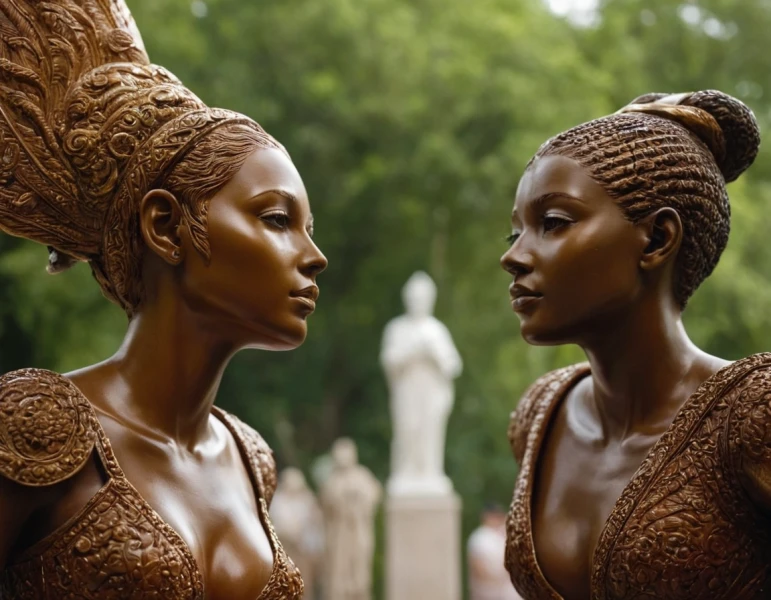Educa UNIVERSITY|ART AND ARCHITECTURE
Sculptures: The art of bringing matter to life
Related Masters
Sculptures: The art of bringing matter to life
Hello, I'm Carlos Hidalgo. Today I come to talk to you about one of my great passions: sculptures. For as long as I can remember, sculptures have fascinated me. Maybe it's that magical ability to take a piece of marble, wood, or even scrap metal, and transform it into something with a soul. That's why I want to share with you everything I know about sculptures, from their history to their most fascinating techniques.
Get ready because this journey will be three-dimensional. I promise that by the end you will see sculptures with different eyes.
What is a sculpture?

If we summarize it in a few words, sculpture is the art of creating three-dimensional forms. These forms can be figurative (like a statue of a hero) or abstract (those that make you wonder "what does it mean?"). What defines them is that they take up space, have volume, and are often made to be viewed from all angles.
The term "sculpture" comes from the Latin sculptūra, which means "to sculpt" or "to engrave."
The term "sculpture" comes from the Latin sculptūra, meaning "to sculpt" or "to engrave. And while we think of marble, sculpture has adapted over the centuries to include materials as diverse as bronze, clay, wood, plastic, and even light or sound.
A look at the history of sculpture
Sculpture has roots as deep as humanity itself. From the small Paleolithic Venuses to contemporary digital works, it has been a form of cultural and spiritual expression.
Classical antiquity: The Greeks and Romans brought it to the pinnacle with works that still leave us speechless today, such as Michelangelo's David or the Venus of Milo. Here was born sculptural realism and the interest in ideal human proportions.
Medieval period: In Europe, sculpture became more religious, decorating cathedrals and temples. Many of these artists remained anonymous, but left an indelible legacy in stone and polychrome wood.
Renaissance: This period was a literal revival of classical ideals. Michelangelo and Donatello are two names you can't forget. Here technical prowess was combined with a deeper search for human and naturalistic expression.
Modernism and contemporaneity: Sculptures broke the rules. Surrealism, cubism and conceptual art brought new forms and materials. Artists such as Auguste Rodin or Henry Moore redefined three-dimensional art, and others such as Javier Marín brought Mexican sculpture into the contemporary world.
Types of sculptures
Did you know that not all sculptures are the same? Depending on their shape and technique, we can classify them into:
- Bulto redondo: Independent works that you can completely surround. The Thinker by Rodin is a good example.
- Relief: Images that protrude from a surface, such as the friezes of the Parthenon. They can be high, low or half reliefs.
- Kinetic sculptures: Designed to move or give the sensation of movement. Alexander Calder was a pioneer in this type of work.
Also, sculptures don't just decorate; some tell stories or symbolize profound ideas. Remember the Moai on Easter Island? They are not simple blocks of stone; they are guardians of the past.
Sculpture techniques: from hammer to laser
Creating a sculpture is not just a matter of inspiration. It is a technical art that combines tools, skill and patience. How are they made?
1. Carving
The most traditional technique. It is worked subtractively, removing material until the desired shape emerges. It is used on marble, stone or wood. It is the Michelangelo method.
2. Modeling
Here malleable material such as clay or wax is used to create shapes. It is ideal for those who prefer to "build" rather than sculpt.
3. Casting
A mold is used to shape the material, such as bronze or resin. This technique allowed for the famous replicas of Roman busts.
4. Assembly
A modern touch: different (sometimes recycled) pieces are taken and joined together to create abstract or figurative sculptures.
5. Polishing
This technique complements others, providing a smooth, shiny finish, especially on marble or metals.
The cultural impact of sculpture
Sculptures are not just decoration. They have played crucial roles in religion, politics and artistic expression. Think of how statues of Roman rulers were propaganda tools, or how figures of saints in medieval churches inspired faith.
Today, sculptures have a special place in museums and public spaces alike. Have you come across a contemporary installation that invites you to interact? That's sculpture too.
Final thought
Sculpture is not just art; it is a bridge between the tangible and the intangible, between idea and form. As Rodin said: "Art is contemplation; it is the pleasure of the spirit that penetrates nature and discovers that it too has a soul."
So the next time you see a sculpture, don't take it lightly. Ask yourself what story it wants to tell you and let its three-dimensional magic envelop you.
Faculties
Trainings
The faculties embrace diverse academic disciplines and fields of study, opening doors to new perspectives and exploring different spheres of wisdom in a constantly evolving world.














